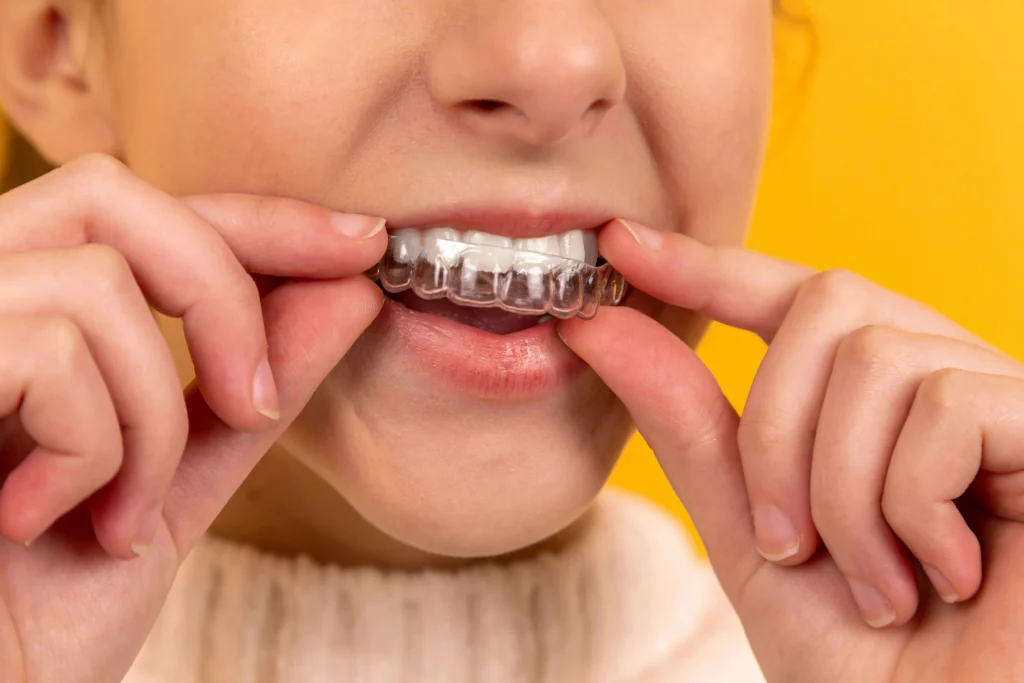Invisalign has revolutionized orthodontics by providing a non-invasive and removable means of straightening teeth, but some patients find they need to have their work refined before they can achieve their end results. These refinements are a normal and anticipated aspect of therapy in several individuals, and they assist fine-tune movement of teeth and seal tiny gaps that might be left behind following the initial aligners. The truth is that refinements can easily distinguish between a smile that appears to look good and one that is completely full and balanced.
Refinements, which are far better than a setback, are the precision that Invisalign takes pride in. They make sure that your result looks just like the well-planned treatment plan your dentist or orthodontist worked out, and also correct any minor changes that might have taken place during the process. Refinements should be thought of as the finishing touch – a means of ensuring that your smile not only looks straight but also works and lasts well.
What Are Invisalign Refinements?

Invisalign refinements are extra series of aligners that adjust your smile once the first phase of treatment is done. Even after a thoroughly thought-out Invisalign process, teeth do not necessarily move in the manner they are expected to, and minor corrections can be made to get the best possible outcome. Refinements are also used to correct these small differences so that when you come out with your final smile, it is not only straighter, but also balanced, functional and long lasting.
How Refinements Differ from Your Initial Invisalign Plan
When you begin Invisalign therapy, your dentist scans your teeth in 3D and prepares a unique series of aligners that are intended to move your teeth over time. Refinements are applied when the movements of your teeth do not match what was predicted. Rather than having to restart again, your dentist will update the scan and will order more trays that will be used to close the gap between where your teeth are and where they need to be.
Reasons Your Dentist Might Recommend Refinements
Refinements can be suggested when your teeth are not moving according to the predicted trajectory, when your bite changes during the course of treatment or when small gaps are left after the last tray. They also occur frequently when aligners were not used as often as they should have been. Whatever the cause, the effect is the same, additional trays that correct your smile and hold it to the track.
Are Refinements Common or a Sign of Treatment Failure?
Refinements are not an indication that your Invisalign procedure is not working, quite to the contrary, most patients need refinements. Indeed, most Invisalign users undergo one or more refinements until they achieve their final outcome. This is because all smiles are different, and teeth may react differently to certain factors such as bone density, age, and even genetics. This is something that your provider remembers at the very outset and this is why refinements are factored in most treatment plans as a fine-tuning mechanism, rather than a surprise.
When Invisalign Refinements Are Necessary

Even with proper planning, your teeth do not always move in the direction that was predicted during Invisalign treatment. Refinements are add-on aligners that help correct any remaining problems–a minor gap, minor crowding, or a change to your bite. They keep your smile in line and complete it as accurately as your provider wanted.
Teeth Not Tracking as Expected
Tracking is used to describe the quality of your teeth movement in relation to the initial digital treatment plan. The aligners only need to make minor and specific adjustments each time, though, when your teeth do not follow suit, the aligners might not fit as snugly as they ought to. You can also find that there are minor spaces between the trays and your teeth, or that the aligner does not fit all the way. When this occurs refinements are usually required to put the treatment path back on course. Without this the other trays may not be effective and it may be difficult to obtain the final result which your provider has planned out.
Mid-Treatment Adjustments to Your Bite or Alignment
As your teeth gradually shift, your bite may also change in ways that weren’t part of the original plan. This can lead to uneven pressure, discomfort, or changes in how your upper and lower jaws meet. If left uncorrected, these bite issues could affect both comfort and long-term oral health. Refinement aligners are designed to fine-tune your bite, ensuring that your teeth come together properly. This way, your final outcome is not only visually appealing but also balanced, functional, and healthier for your jaw and smile overall.
Post-Treatment Gaps or Crowding Reappearance
Even when the patient finishes with the primary series of aligners some still find little flaws such as slight gaps, tiny rotations, or slight crowding that were not completely corrected. Those are small details but when it comes to appearance and functionality, they can be significant. Refinements are the icing on the cake, they give your smile the final touch and make sure you do not leave anything behind.
What to Expect During the Refinement Process

Refinements are a natural part of many Invisalign journeys, designed to make sure your smile reaches its full potential. While the initial aligner sets handle the majority of tooth movement, refinements fine-tune the details for a precise, polished result. This stage is typically straightforward and follows a clear process so you’ll know exactly what’s happening at every step.
Getting a New 3D Scan and Updated Aligner Trays
Refinements normally start with a new digital scan of your teeth. With this new model, your provider can check the extent to which your smile has improved over the initial plan and where minor corrections are still required. Based on this information, Invisalign creates a new set of trays that is specifically designed to address those final details: whether it is sealing small gaps, rotating a few teeth, or improving the overall fit. These trays are similar to your original aligners except that they are more focused on the final details.
Treatment Timeline with Refinements
Invisalign refinements will take different lengths based on the amount of movement required of your teeth. In certain patients, it only takes a couple of additional trays that can be done within a few weeks. Others might require a more gradual process, which can be refined over a number of months to produce the best outcome. Your dentist will thoroughly evaluate your progress and give you a new timeline so you have a clear picture of what to expect and how much closer you are to your final smile.
Will It Cost Extra to Get Invisalign Refinements?
Refinements may be more or less expensive depending on your provider and the specifics of your treatment contract. The initial Invisalign price is in most cases already inclusive of one or more refinements. But in case your treatment involves any further refinements than included in the treatment, additional charges might be incurred. The best way to prevent surprises is to discuss financial coverage with your dentist and make sure you are fully informed of what is covered and what might require an extra charge before beginning treatment.
How to Prevent the Need for Refinements
It is advisable to be very consistent with your Invisalign plan to minimize the likelihood of subsequent refinements. Although you can not prevent them all, there are measures that can ensure your teeth move as intended. You will help ensure that the treatment process is smoother and more efficient as you follow the instructions of your dentist and adhere to good habits.
Following Your Aligner Wear Schedule Precisely
Inequal wear of your aligners is the most frequent reason that causes refinements to be made. Invisalign trays are programmed to perform best when they are worn 20-22 hours a day, during which time the teeth will gradually be displaced according to the treatment schedule. Excessive removal, not wearing them at night, or forgetting to replace them after you have eaten can slow down the process and make your teeth move out of place. Wearing aligners consistently will keep your treatment on schedule, and may also reduce the number of additional refinements you need to make, to achieve your final smile on time.
Using Attachments and Chewies as Directed
Attachments- tiny tooth-colored bumps attached to certain teeth assist your aligners to hold and move teeth in a better way. Chewies are soft silicone balls to ensure that every tray is in place and fits perfectly around your teeth. Missing or not using these tools can decrease the effectiveness of your aligners, slowing down the process and raising the chances that you will need to re-do the aligners in the future.
Following the treatment instructions, in the case of attachments and chewies, you provide your treatment with the best chance to remain on schedule and produce the intended outcome within the planned time frame.
Avoiding DIY Fixes or Skipping Aligner Sets
It is possible that some patients will be tempted to go without aligners one or two days or attempt to coerce trays into moving quicker than expected. Some would also try to bend or cut their aligners themselves in order to accelerate the process. These shortcuts will not only interfere with how your teeth are supposed to move, but they will also cause new issues.
In the vast majority of cases, this means trying to accelerate the treatment process, which, in fact, reduces the chances of having to make corrections that would have been avoided by adhering to the scheme of action. The best way to ensure that you get the exact output that your provider has planned is to be consistent and patient with your aligners.
Frequently Asked Questions (FAQs)
1. What are Invisalign refinements?
Refinements are extra sets of aligners made during or after your main treatment to address teeth that haven’t shifted exactly as planned. Even with advanced technology, teeth don’t always move perfectly on schedule. Refinements allow your provider to make small adjustments and fine-tune your smile for a more accurate outcome. The process doesn’t mean starting over—it simply builds on the progress you’ve already achieved. For many patients, refinements are a normal and expected part of clear aligner treatment. They ensure your teeth reach their ideal positions. Think of refinements as the final polish that brings your treatment results to their highest potential.
2. Are refinements covered in the original Invisalign cost?
Many providers include at least one round of refinements in the original treatment fee, since minor adjustments are often expected. However, policies can vary, and some offices may charge for additional sets if more than one refinement is needed. This is why it’s important to ask about refinement costs before beginning treatment. Knowing what’s included in your plan helps you avoid surprises later. A clear conversation with your provider ensures you understand both the process and any possible expenses along the way. Would you like me to also make this more patient-friendly, like how a dental office would phrase it for their website?
3. How many refinements can I get during treatment?
There isn’t a strict limit on refinements, but most patients only need one or two rounds to achieve their final results. The exact number depends on how your teeth respond to treatment and how consistently you wear your aligners as directed. If your teeth move more slowly or unexpectedly, additional refinements may be recommended. Your provider will carefully track your progress at each check-in. Based on these evaluations, they’ll decide whether more refinements are necessary to perfect your smile.
4. Will refinements delay my results?
Yes, refinements can sometimes extend your treatment time, but the extra wait is almost always worth it. A few additional weeks or months can make the difference between a good result and the confident, polished smile you’ve been working toward. Think of refinements as fine-tuning the details rather than starting over from scratch. It’s the last step that helps ensure your smile matches the original plan as closely as possible.
5. Is it normal to need multiple refinement rounds?
Yes, it can be completely normal. Teeth don’t always move in a perfectly predictable way, which is why some patients need more than one round of refinements. This doesn’t mean your treatment isn’t working—it simply means your provider is fine-tuning your smile to get the best possible outcome. Think of it as an extra layer of precision to make sure every detail lines up just right.
Call to Action
Refinements are a natural step in the Invisalign journey for many patients. They aren’t a setback, but rather an opportunity to ensure every detail of your smile aligns with your treatment goals. By wearing your aligners consistently, using attachments and chewies as directed, and working closely with your provider, you can reduce the chances of needing extensive refinements.
If you’ve been told you may need refinements, don’t be discouraged. They’re a normal part of treatment and a sign that your provider is committed to delivering the best results possible. Think of refinements as the final polish that takes your smile from “almost there” to truly finished.
Ready to explore Invisalign or learn more about refinements? Schedule a consultation with Graham Park Dental today. With expert guidance and consistent care, you can achieve a smile that feels healthy, natural, and confident—without shortcuts.


